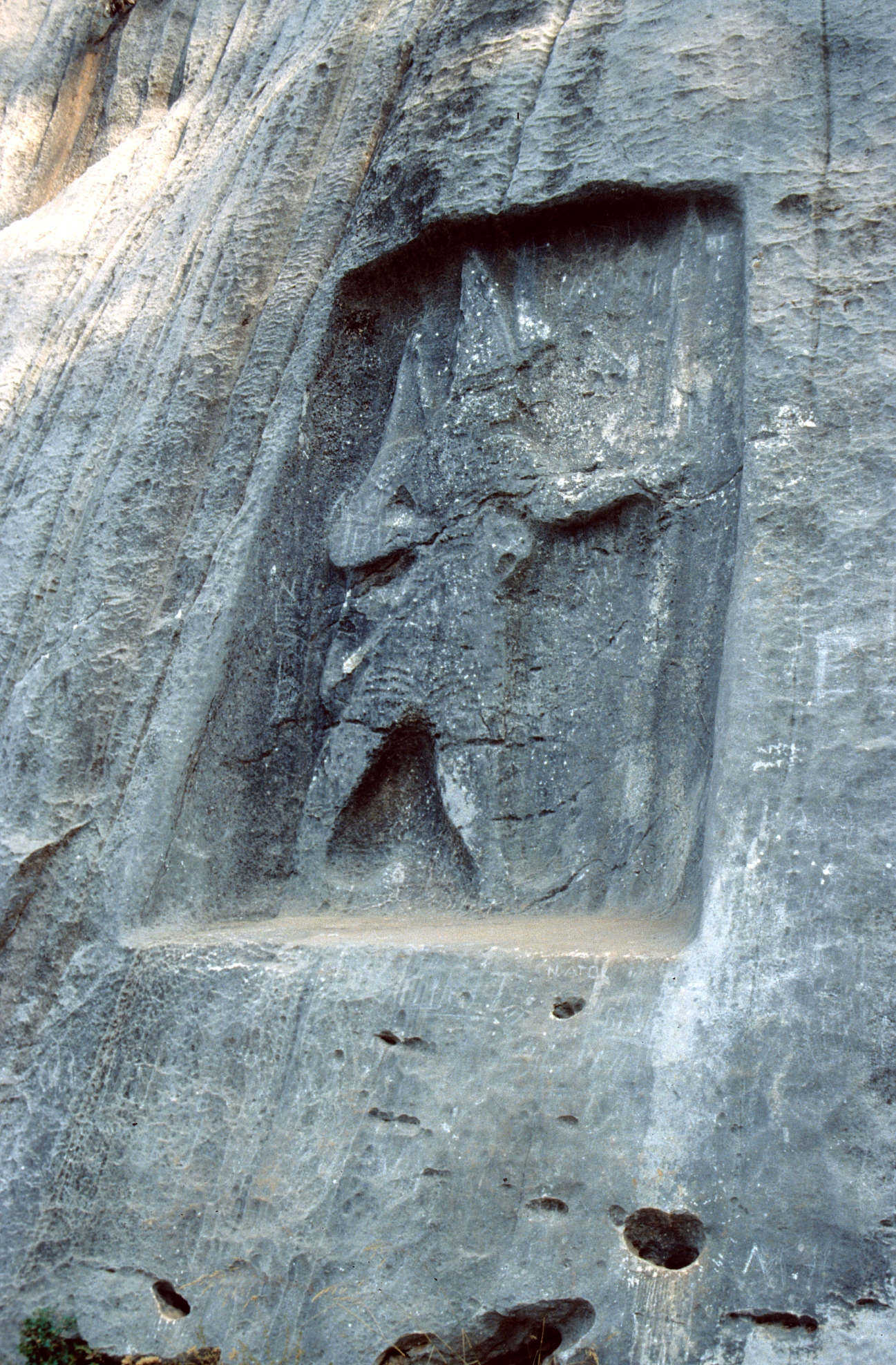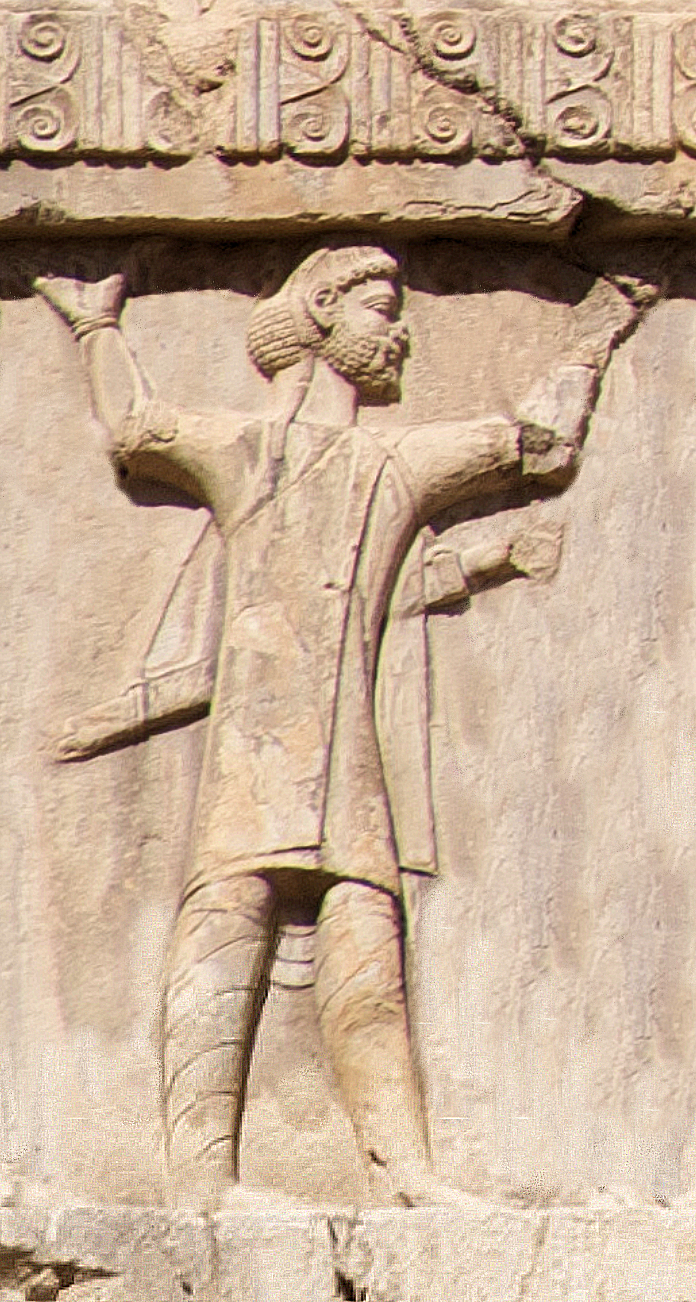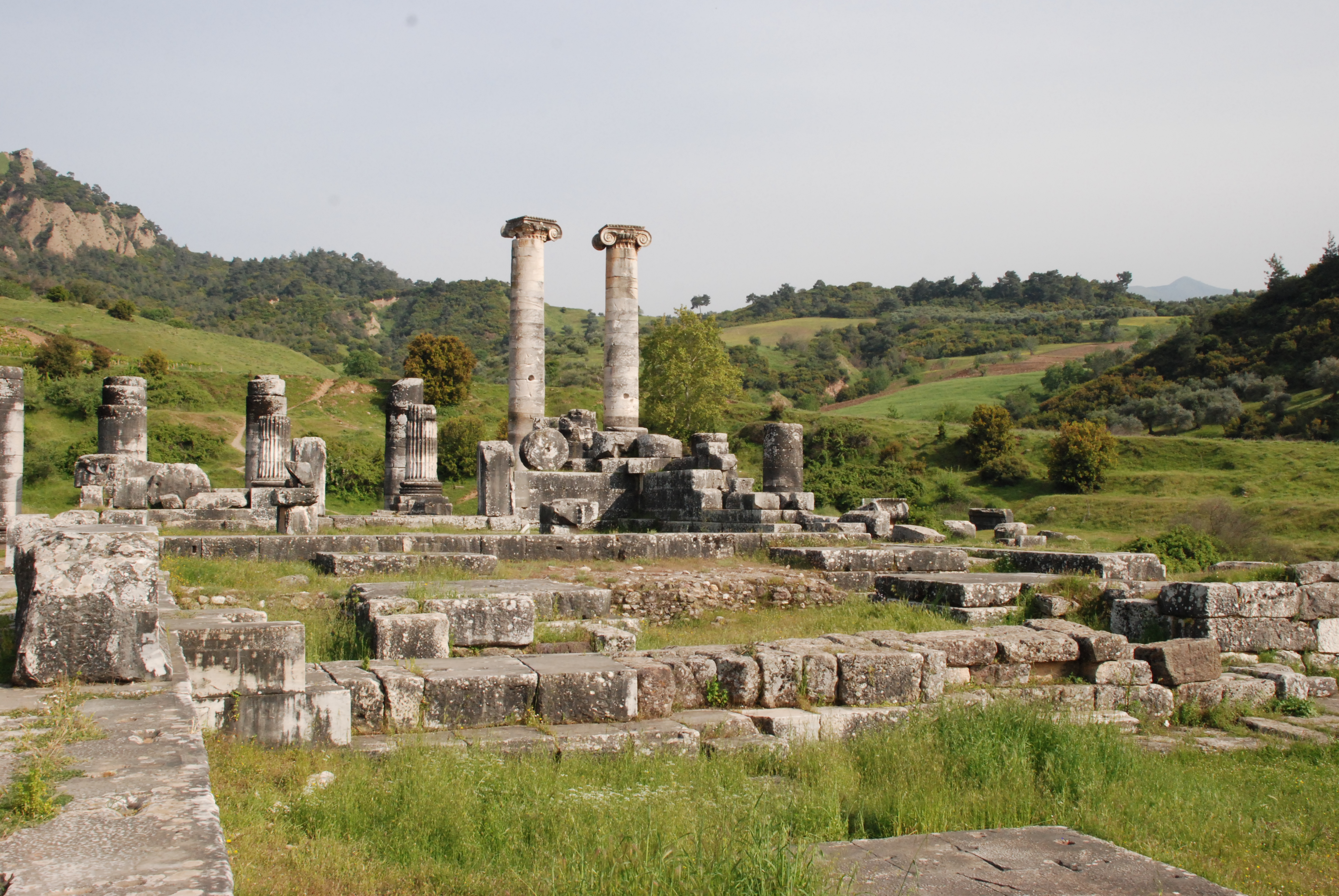|
Kaymakçı (archaeological Site)
Kaymakçı is a Bronze Age archaeological site overlooking Marmara Lake in Manisa Province, Turkey. Given its size and location, the settlement is considered a leading candidate for the capital city of the Seha River Land. Archaeology Occupation at Kaymakçı began in the Middle Bronze Age, and it became a major settlement during the Late Bronze Age. The site was settled continuously from 1700 BC to 1200 BC, contemporary with Troy VI and VIIa. Some occupation continued into the Iron Age, though it was no longer a major urban center. Like other citadels in the area, Kaymakçı shows evidence of having been burned, but it is unknown whether this destruction caused the abandonment of the site or dates from an earlier sacking. The site covers an area of at least 25 hectares, spanning across 1 kilometer of a bedrock ridge. Its elevation 140 meters over the lake provides a commanding view of the surrounding area. It consists of a 8.6 hectare citadel, a sprawling lower town, as well ... [...More Info...] [...Related Items...] OR: [Wikipedia] [Google] [Baidu] |
Seha River Land
The Seha River Land was a kingdom in Western Anatolia Anatolia (), also known as Asia Minor, is a peninsula in West Asia that makes up the majority of the land area of Turkey. It is the westernmost protrusion of Asia and is geographically bounded by the Mediterranean Sea to the south, the Aegean ... in the Late Bronze Age known from Hittite texts. Part of Arzawa, it was located north of Kingdom of Mira, Mira and south of Wilusa, and at one point controlled the island of Lesbos, Lazpa. History The Seha River Land was a reluctant vassal state of the Hittite Empire, and much of its known history was turbulent. The ''Annals of Mursili II'' recount how the Hittite king Mursili II consolidated power over the region around 1320 BC, crushing a revolt in which the Seha River Land participated. According to Mursili, he besieged the Seha River Land's capital and was on the verge of destroying it when he accepted a last minute mercy plea from Manapa-Tarhunta, King Manapa-Tarhunta's ... [...More Info...] [...Related Items...] OR: [Wikipedia] [Google] [Baidu] |
Manapa-Tarhunta Letter
The Manapa-Tarhunta letter ( CTH 191; KUB 19.5 + KBo 19.79) is a fragmentary text in the Hittite language from the 13th century BC. The letter was sent to the Hittite king by Manapa-Tarhunta, client king of the Seha River Land. In the letter, Manapa-Tarhunta discusses Hittite attempts to reassert control over northwest Anatolia. The letter is particularly notable for its mention of Wilusa, generally identified with Troy. Content The letter identifies its author as Manapa-Tarhunta, client king of the Seha River Land. Manapa-Tarhunta is discussed in other Hittite documents, which indicate that he was already in power when Mursili II ascended the Hittite throne in 1321 BC, and that he was removed from power by Muwatalli II, who ruled from 1295 to 1272 BC. While the addressee is not explicitly named, scholars generally agree that it was Muwatalli II. The letter begins by assuring Muwattalli, " t the momenteverything is fine". In the next section, it reports that Hittite troops arri ... [...More Info...] [...Related Items...] OR: [Wikipedia] [Google] [Baidu] |
Archaeological Sites Of Prehistoric Anatolia
Archaeology or archeology is the study of human activity through the recovery and analysis of material culture. The archaeological record consists of artifacts, architecture, biofacts or ecofacts, sites, and cultural landscapes. Archaeology can be considered both a social science and a branch of the humanities. It is usually considered an independent academic discipline, but may also be classified as part of anthropology (in North America – the four-field approach), history or geography. The discipline involves surveying, excavation, and eventually analysis of data collected, to learn more about the past. In broad scope, archaeology relies on cross-disciplinary research. Archaeologists study human prehistory and history, from the development of the first stone tools at Lomekwi in East Africa 3.3 million years ago up until recent decades. Archaeology is distinct from palaeontology, which is the study of fossil remains. Archaeology is particularly important for lear ... [...More Info...] [...Related Items...] OR: [Wikipedia] [Google] [Baidu] |
Kingdom Of Mira
Mira (ca. 1330–1190 BC), in the Late Bronze Age, was one of the semi-autonomous vassal state kingdoms that emerged in western Anatolia (Asia Minor) following the defeat and partition of the larger kingdom of Arzawa by the victorious Suppiluliuma I of the Hittite Empire. A significantly smaller Arzawa continued, centered on Apasa (Ephesus), with Mira to the east. Location According to the current understanding, Mira's northern border with the Seha River Land was marked by the Karabel relief. This was first proposed in 1975 by Hans Gustav Güterbock and confirmed by John David Hawkins decipherment of the inscription on the relief in 1998. The southern border with the Lukka lands was probably at Milas, while the eastern border with Hapalla and the Hittite kingdom may have been somewhere around Afyon.Horst Ehringhaus: ''Götter, Herrscher, Inschriften – Die Felsreliefs der hethitischen Großreichszeit in der Türkei'', von Zabern 2005 p. 91 Borders with other territories, ... [...More Info...] [...Related Items...] OR: [Wikipedia] [Google] [Baidu] |
Hittite Empire
The Hittites () were an Anatolian peoples, Anatolian Proto-Indo-Europeans, Indo-European people who formed one of the first major civilizations of the Bronze Age in West Asia. Possibly originating from beyond the Black Sea, they settled in modern-day Turkey in the early 2nd millennium BC. The Hittites formed a series of Polity, polities in north-central Anatolia, including the kingdom of Kussara (before 1750 BC), the Kültepe, Kanesh or Nesha Kingdom (–1650 BC), and an empire centered on their capital, Hattusa (around 1650 BC). Known in modern times as the Hittite Empire, it reached its peak during the mid-14th century BC under Šuppiluliuma I, when it encompassed most of Anatolia and parts of the northern Levant and Upper Mesopotamia, bordering the rival empires of the Hurri-Mitanni and Assyrians. Between the 15th and 13th centuries BC, the Hittites were one of the dominant powers of the Near East, coming into conflict with the New Kingdom of Egypt, the Middle Assyrian Empi ... [...More Info...] [...Related Items...] OR: [Wikipedia] [Google] [Baidu] |
Cities Of The Ancient Near East
The earliest cities in history were in the ancient Near East, an area covering roughly that of the modern Middle East: its history began in the 4th millennium BC and ended, depending on the interpretation of the term, either with the conquest by the Achaemenid Empire in the 6th century BC or with that by Alexander the Great in the 4th century BC. The largest cities of the Bronze Age Near East housed several tens of thousands of people. Memphis in the Early Bronze Age, with some 30,000 inhabitants, was the largest city of the time by far. Ebla is estimated to have had a population of 40,000 inhabitants in the Intermediate Bronze age. Ur in the Middle Bronze Age is estimated to have had some 65,000 inhabitants; Babylon in the Late Bronze Age similarly had a population of some 50,000–60,000. Niniveh had some 20,000–30,000, reaching 100,000 only in the Iron Age (around 700 BC). In Akkadian and Hittite orthography, URU became a determinative sign denoting a city, or combine ... [...More Info...] [...Related Items...] OR: [Wikipedia] [Google] [Baidu] |
Lydian Language
Lydian is an extinct Indo-European language, Indo-European Anatolian languages, Anatolian language spoken in the region of Lydia, in western Anatolia (now in Turkey). The language is attested in graffiti and in coin legends from the late 8th century or the early 7th century to the 3rd century BCE, but well-preserved inscriptions of significant length are so far limited to the 5th century and the 4th century BCE, during the period of Achaemenid Empire, Persian domination. Thus, Lydian texts are effectively contemporaneous with those in Lycian language, Lycian. Strabo mentions that around his time (1st century BCE), the Lydian language was no longer spoken in Lydia proper but was still being spoken among the multicultural population of Kibyra (now Gölhisar) in southwestern Anatolia, by the descendants of the Lydians, Lydian colonists, who had founded the city. Text corpus and decipherment In 1916 the Sardis bilingual inscription, a bilingual inscription in Aramaic and Lydian all ... [...More Info...] [...Related Items...] OR: [Wikipedia] [Google] [Baidu] |
Hieroglyphic Luwian
Luwian (), sometimes known as Luvian or Luish, is an ancient language, or group of languages, within the Anatolian languages, Anatolian branch of the Indo-European languages, Indo-European language family. The ethnonym Luwian comes from ''Luwiya'' (also spelled ''Luwia'' or ''Luvia'') – the name of the region in which the Luwians lived. Luwiya is attested, for example, in the Hittite laws. The two varieties of Luwian are known after the scripts in which they were written: #Cuneiform Luwian, Cuneiform Luwian (''CLuwian'') and Hieroglyphic Luwian (''HLuwian''). There is no consensus as to whether these were a single language or two closely related languages. Classification Several other Anatolian languages – particularly Carian language, Carian, Lycian language, Lycian, and Milyan (also known as Lycian B or Lycian II) – are now usually identified as related to Luwian – and as mutually connected more closely than other constituents of the Anatolian branch.Anna Bauer, 2014, ... [...More Info...] [...Related Items...] OR: [Wikipedia] [Google] [Baidu] |
Lydians
The Lydians (Greek language, Greek: Λυδοί; known as ''Sparda'' to the Achaemenids, Old Persian cuneiform Wikt:𐎿𐎱𐎼𐎭, 𐎿𐎱𐎼𐎭) were an Anatolians, Anatolian people living in Lydia, a region in western Anatolia, who spoke the distinctive Lydian language, an Indo-European languages, Indo-European language of the Anatolian languages, Anatolian group. Questions raised regarding their origins, reaching well into the 2nd millennium BC, continue to be debated by language historians and archeologists. A distinct Lydian culture lasted, in all probability, until at least shortly before the Common Era, having been attested the last time among extant records by Strabo in Kibyra in south-west Anatolia around his time (1st century BC). The Lydian capital was at ''Sfard'' or Sardis. Their recorded history of statehood, which covers three dynasties traceable to the Late Bronze Age, reached the height of its power and achievements during the 7th and 6th centuries BC, a ... [...More Info...] [...Related Items...] OR: [Wikipedia] [Google] [Baidu] |
Sardis
Sardis ( ) or Sardes ( ; Lydian language, Lydian: , romanized: ; ; ) was an ancient city best known as the capital of the Lydian Empire. After the fall of the Lydian Empire, it became the capital of the Achaemenid Empire, Persian Lydia (satrapy), satrapy of Lydia and later a major center of Hellenistic Greece, Hellenistic and Byzantine Greeks, Byzantine culture. Now an active archaeological site, it is located in modern day Turkey, in Manisa Province, near the town of ''Sart, Salihli, Sart''. History Sardis was occupied for at least 3500 years. In that time, it fluctuated between a wealthy city of international importance and a collection of modest hamlets. Early settlement Sardis was settled before 1500 BC. However, the size and nature of early settlement is not known since only small extramural portions of these layers have been excavated. Evidence of occupation consists largely of Late Bronze Age and Early Iron Age pottery which shows affinities with Mycenaean Greece and ... [...More Info...] [...Related Items...] OR: [Wikipedia] [Google] [Baidu] |
Lydia
Lydia (; ) was an Iron Age Monarchy, kingdom situated in western Anatolia, in modern-day Turkey. Later, it became an important province of the Achaemenid Empire and then the Roman Empire. Its capital was Sardis. At some point before 800 BC, the Lydian people achieved some sort of political cohesion, and existed as an independent kingdom by the 600s BC. At its greatest extent, during the 7th century BC, it covered all of western Anatolia. In 546 BC, it became a Lydia (satrapy), satrapy of the Achaemenid Empire, known as ''Sparda'' in Old Persian. In 133 BC, it became part of the Roman Republic, Roman Asia (Roman province), province of Asia. Lydian coins, made of electrum, are among the oldest in existence, dated to around the 7th century BC. Geography Lydia is generally located east of ancient Ionia in the modern western Turkish provinces of Uşak Province, Uşak, Manisa Province, Manisa and inland İzmir Province, İzmir.Rhodes, P.J. ''A History of the Classical Greek ... [...More Info...] [...Related Items...] OR: [Wikipedia] [Google] [Baidu] |







